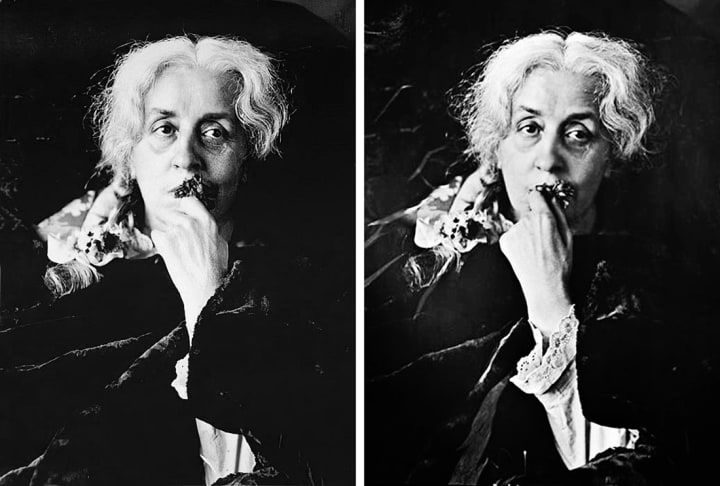What is "presence" in portrait photography?
Although this concept may be somewhat challenging to articulate verbally, its vivid manifestation becomes strikingly apparent upon observation. Read on…

In the world of portraiture, there is an elusive yet powerful element that possesses the uncanny ability to seize the viewer's undivided attention—the presence of the subject. This concept can be kind of hard to explain in words. However, it emerges with unmistakable clarity when we turn our gaze to its manifestation in visual art.
Consider, for instance, the pair of portrait photographs featuring the enigmatic Ernestine Constance Lefebre, expertly captured by the lens of Nadar. In one of these portraits, Ernestine exudes an overwhelming sense of presence with her piercing gaze fixing on the observer. Those eyes looking at you are leaving an indelible impression that refuses to be ignored. In contrast, the other picture portrays Ernestine in a manner that appears disconnected from the photographer's lens, resulting in an image that, while undoubtedly skillfully composed, lacks the riveting magnetism found in the former. It's important to emphasize that this discrepancy goes beyond the simple act of making eye contact with the camera or not. In fact, let us look at two other photographs in which we can see more presence in one and less in the other: two portrait shots of Djuna Barnes by Berenice Abbott. In both of them the subject is looking at the camera, but in one she is much more present. What is this unmistakable "presence" of the subject that has the power of drawing the viewer's attention like a magnetic force?


It's the feeling that that person is here and now, with you, not absorbed in other thoughts but somehow connected with the viewer.
This captivating quality that seems to effortlessly draw our attention isn't limited to photography alone; it also makes its presence felt in some paintings. Take, for instance, the undeniable "presence" emanating from Giovan Battista Moroni's portrait of Sarto, a presence that captivates the beholder's gaze.
Here a question arises: is this elusive "presence" solely a creation within the painting, shaped and interpreted by the artist, or does it exist inherently within the subject? Paintings, after all, are representations of reality filtered through the artist's vision, potentially idealized or subjective in their interpretation.
On the other hand, photography is often regarded as a technical reproduction that cannot lie, a reflection of the objective reality it captures. But is this notion entirely accurate? Perhaps not. As Lewis Hine once argued, "liars may photograph," implying that even in photography, there exists the potential for selective portrayal and the photographer can be discriminatory about what is shown.
This is certainly true and - in addition - I propose a different perspective. Consider that a skilled photographer possesses the unique ability to capture something not readily apparent to everyone. Maybe it's precisely the intensity of the subject's presence that they know how to invite and photograph — a profound intensity that might otherwise remain hidden.
Mind you, knowing how to capture an unobvious aspect of a person's character isn't achieved by instructing the subject to play a role (then it would no longer be a portrait), but rather by recognizing the depth of the subject's presence and skillfully immortalizing it through the lens.
That’s why it’s so important for a portrait photographer being able to connect with the subject and invite that orientation, mood, disposition, inclination… that is so hard to describe with words. Presence is what makes a difference in portraits. When a photographer manages to connect with the subject and capture a certain presence, the viewer will also perceive it.
There are portraits that lack that quality and the subject has a formal smile or seems to have no connection with the photographer and hence with the viewer. Those portraits can – of course – be interesting, but tend to capture our attention less.
Presence often attracts our gaze and curiosity as a magnet, maybe because we perceive a certain strength in those subjects and we tend to like powerful and impactful images.
---------------------------------------------------------------------------------------
Enzo Dal Verme is an Italian portrait photographer drawing on over three decades of experience in meditation. He approaches photography as a path of self-discovery and personal growth.
His portraits have been published in Vanity Fair, l'Uomo Vogue, The Times, GQ, Elle and many other international magazines.
He teaches at the Portrait Photography Retreats and has over 15 years of experience facilitating groups.
About the Creator
enzo dal verme
Portrait Photographer Powered By Tofu. Published in Vanity Fair, l’Uomo Vogue, D di Repubblica, Marie Claire, The Times, GQ, Grazia, Madame Figaro, Glamour, Elle…






Comments
enzo dal verme is not accepting comments at the moment
Want to show your support? Send them a one-off tip.